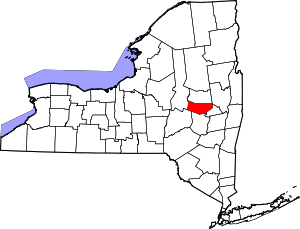Hagaman, New York
| Hagaman, New York | |
|---|---|
| Village | |
 Hagaman, New York Location within the state of New York | |
| Coordinates: 42°58′39″N 74°9′2″W / 42.97750°N 74.15056°WCoordinates: 42°58′39″N 74°9′2″W / 42.97750°N 74.15056°W | |
| Country | United States |
| State | New York |
| County | Montgomery |
| Area[1] | |
| • Total | 1.5 sq mi (4.0 km2) |
| • Land | 1.5 sq mi (4.0 km2) |
| • Water | >0.0 sq mi (>0.0 km2) |
| Elevation | 719 ft (219 m) |
| Population (2010) | |
| • Total | 1,292 |
| Time zone | Eastern (EST) (UTC-5) |
| • Summer (DST) | EDT (UTC-4) |
| ZIP code | 12086 |
| Area code(s) | 518 |
| FIPS code | 36-31291 |
| GNIS feature ID | 0951983 |
Hagaman (/ˈheɪɡəmən/) is a village in Montgomery County, New York, United States. The population was 1,292 at the 2010 census. It is named after Joseph Hagaman, the founding father.
The Village of Hagaman is in the Town of Amsterdam, northeast of the City of Amsterdam.
History
The community was formerly called "Hagamans Mills." It was founded around 1777. Village offices are located in the historic Pawling Hall, listed on the National Register of Historic Places in 2002.[2]
Current leadership
The village of Hagaman currently has Robert Tom Krom as the mayor, with several other trustees serving as a legislature.
Geography
Hagaman is located at 42°58′39″N 74°9′2″W / 42.97750°N 74.15056°W (42.977531, -74.150493).[3]
According to the United States Census Bureau, the village has a total area of 1.5 square miles (3.9 km2), all of it land.
Demographics
| Historical population | |||
|---|---|---|---|
| Census | Pop. | %± | |
| 1870 | 250 | — | |
| 1890 | 596 | — | |
| 1900 | 646 | 8.4% | |
| 1910 | 875 | 35.4% | |
| 1920 | 855 | −2.3% | |
| 1930 | 867 | 1.4% | |
| 1940 | 933 | 7.6% | |
| 1950 | 1,114 | 19.4% | |
| 1960 | 1,292 | 16.0% | |
| 1970 | 1,410 | 9.1% | |
| 1980 | 1,331 | −5.6% | |
| 1990 | 1,377 | 3.5% | |
| 2000 | 1,357 | −1.5% | |
| 2010 | 1,292 | −4.8% | |
| Est. 2015 | 1,299 | [4] | 0.5% |
As of the census[6] of 2000, there were 1,357 people, 557 households, and 374 families residing in the village. The population density was 880.3 people per square mile (340.2/km²). There were 582 housing units at an average density of 377.5 per square mile (145.9/km²). The racial makeup of the village was 97.79% White, 0.44% African American, 0.52% Asian, 0.44% from other races, and 0.81% from two or more races. Hispanic or Latino of any race were 2.21% of the population.
There were 557 households out of which 26.4% had children under the age of 18 living with them, 54.4% were married couples living together, 9.7% had a female householder with no husband present, and 32.7% were non-families. 29.1% of all households were made up of individuals and 15.1% had someone living alone who was 65 years of age or older. The average household size was 2.41 and the average family size was 2.94.
In the village the population was spread out with 22.0% under the age of 18, 7.1% from 18 to 24, 25.6% from 25 to 44, 27.3% from 45 to 64, and 17.9% who were 65 years of age or older. The median age was 42 years. For every 100 females there were 99.3 males. For every 100 females age 18 and over, there were 93.1 males.
The median income for a household in the village was $41,875, and the median income for a family was $52,500. Males had a median income of $32,463 versus $25,319 for females. The per capita income for the village was $19,527. About 3.8% of families and 6.7% of the population were below the poverty line, including 7.2% of those under age 18 and 13.6% of those age 65 or over.
References
- ↑ Water area is negligible.
- ↑ National Park Service (2009-03-13). "National Register Information System". National Register of Historic Places. National Park Service.
- ↑ "US Gazetteer files: 2010, 2000, and 1990". United States Census Bureau. 2011-02-12. Retrieved 2011-04-23.
- ↑ "Annual Estimates of the Resident Population for Incorporated Places: April 1, 2010 to July 1, 2015". Retrieved July 2, 2016.
- ↑ "Census of Population and Housing". Census.gov. Retrieved June 4, 2015.
- ↑ "American FactFinder". United States Census Bureau. Retrieved 2008-01-31.
